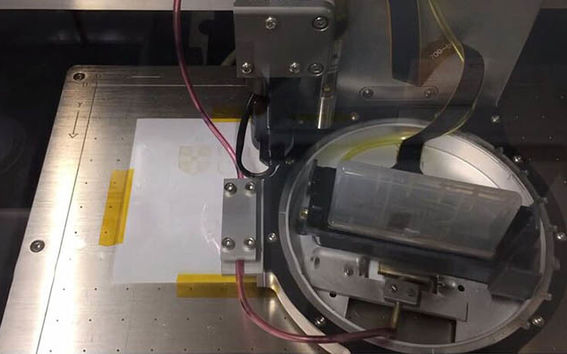Researchers printed graphene-like materials with inkjet

New black phosphorous inks are compatible with conventional inkjet printing techniques for optoelectronics and photonics.
Since the discovery of the Nobel Prize winning material graphene, many new nanomaterials promise to deliver exciting new photonic and optoelectronic technologies. Black phosphorous is a particularly interesting post-graphene nanomaterial for next generation photonic and optoelectronic devices. Yet despite remarkable performance in the lab, practical real-world exploitation of this material has been hindered by complex material fabrication and its poor environmental stability. “Our inkjet printing demonstration makes possible for the first time the scalable mass fabrication of black phosphorous based photonic and optoelectronic devices with long-term stability necessary for a wide range of industrial applications”, tells Professor Zhipei Sun at Aalto University in Finland.
Scientists optimized the chemical composition to achieve a stable ink through the balance of complex and competing fluidic effects. This enabled the production of new functional photonic and optoelectronic devices by inkjet printing with excellent print quality and uniformity - just like the printing of intricate graphics or photographs on paper. The researchers' work demonstrated the benefits of their novel technique by inkjet printing devices that take advantage of the properties of black phosphorous, not least its semiconducting bandgap that can be readily varied by engineering the number of atomic layers and can cover the visible and near-infrared region of the electromagnetic spectrum.
The researchers also demonstrated printed black phosphorous based nonlinear optical devices that can be easily inserted into lasers to act as ultra-quick optical shutters, converting a continuous beam of laser radiation into a repetitive series of very short bursts of light suited for industrial and medical applications, such as machining, imaging and sensing. In the study, black phosphorous was also able to act as an efficient and highly-responsive detector of light, extending the wavelength range over which conventional silicon-based photodetectors can operate.
Importantly, the researchers showed that the black phosphorous ink can be seamlessly integrated with existing complementary metal-oxide-semiconductor (CMOS) technologies, while the inkjet printing technique developed offering the prospect of supporting the fabrication of so-called heterostructured materials that aim to capitalize on the benefits of distinct, yet complementary properties of multiple nanomaterial layers through controlled fabrication.
The new ink was developed by an interdisciplinary team of international researchers at Aalto University, University of Cambridge (UK), Imperial College London (UK) and Beihang University (China). The research was supported by the Academy of Finland, Tekes - the Finnish Funding Agency for Innovation, Nokia Foundation and European Commission.
Journal reference:
G. Hu et.al., Black phosphorus ink formulation for inkjet printing of optoelectronics and photonic, Nature Communications, DOI: 10.1038/s41467-017-00358-1.
Link to the article (nature.com)
Further information:
Professor Zhipei Sun
[email protected]
Tel. +358 50 4302 820
Research group
- Published:
- Updated:
Read more news

Get to know us: Associate Professor Maria Sammalkorpi
Sammalkorpi received her doctorate from Helsinki University of Technology 2004. After her defence, she has worked as a researcher at the Universities of Princeton, Yale and Aalto.
Aalto computer scientists in ICML 2024
Computer scientists in ICML 2024
Getting bacteria into line
Physicists use magnetic fields to manipulate bacterial behaviour